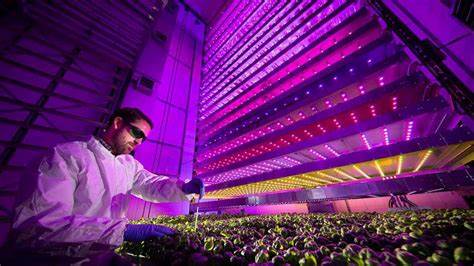
Vertical Farming: Revolutionizing Food Production for a Sustainable
Future
Introduction
Vertical farming and controlled environment agriculture have emerged as innovative solutions to address the challenges of food security and sustainability. By growing crops in vertically stacked layers, often in urban environments, these practices optimize resource utilization and minimize the environmental impact of traditional farming methods.
Historical Background
The concept of vertical farming can be traced back to the Hanging Gardens of Babylon, one of the Seven Wonders of the Ancient World. However, it wasn’t until the advent of modern technology and advancements in hydroponics and aeroponics that vertical farming gained momentum as a viable agricultural method.
Key Concepts and Definitions
Vertical farming involves the cultivation of plants in vertically stacked layers, utilizing methods such as hydroponics, aeroponics, and aquaponics. Hydroponics refers to growing plants without soil, where nutrients are delivered directly to the roots through a nutrient-rich water solution. Aeroponics, on the other hand, involves growing plants in an air or mist environment with nutrients delivered through a fine mist. Aquaponics combines hydroponics and aquaculture, where fish waste provides nutrients for the plants.

Benefits of Vertical Farming
Increased Crop Productivity and Yield: Vertical farming maximizes the use of available space by stacking plants vertically, resulting in higher crop productivity and yield compared to traditional farming methods.
Efficient Use of Space, Water, and Resources: Vertical farming optimizes land use by utilizing vertical space instead of spreading crops horizontally. Additionally, water usage is significantly reduced as water is recirculated within the system. Furthermore, vertical farming minimizes the need for pesticides and herbicides, reducing the overall environmental impact.
Reduction in Reliance on Pesticides and Herbicides: By creating controlled environments, vertical farming reduces the susceptibility of crops to pests and diseases, minimizing the reliance on pesticides and herbicides.
Environmental Sustainability
Reduction in Carbon Footprint and Greenhouse Gas Emissions: Vertical farming can significantly reduce the carbon footprint associated with traditional agriculture, as it requires less transportation and eliminates the need for chemical fertilizers. Additionally, the controlled environment facilitates energy-efficient practices.
Conservation of Land and Natural Resources: Vertical farming allows food production in urban areas, reducing the need for expansive agricultural land. This conservation of land helps preserve natural habitats and biodiversity.
Protection Against Climate Change and Extreme Weather Events: Vertical farms are less susceptible to the adverse effects of climate change and extreme weather events. The controlled environment provides protection against temperature fluctuations, droughts, and floods, ensuring a stable food supply.
Potential for Urban Food Production
Addressing Challenges of Urbanization and Limited Land Availability: As the global population becomes increasingly urbanized, vertical farming offers a solution to produce fresh food in densely populated areas with limited access to arable land.
Bringing Food Production Closer to Consumers and Reducing Transportation Costs: Vertical farms situated in urban centers reduce the distance food travels from farm to plate, decreasing transportation costs and minimizing the carbon emissions associated with long-distance food distribution.

Case Studies or Examples
Numerous successful vertical farming projects have been implemented worldwide. For example, the Sky Greens vertical farm in Singapore utilizes rotating tiers to maximize space and produce leafy greens efficiently. Another notable example is Gotham Greens, operating rooftop greenhouses in New York City, supplying fresh produce year-round to local communities.
Current Trends or Developments
Recent advancements in technology and automation have revolutionized vertical farming. Artificial intelligence and machine learning algorithms are being employed to optimize plant growth, monitor nutrient levels, and manage resource allocation effectively. Furthermore, the integration of renewable energy sources, such as solar power and wind turbines, is reducing the reliance on fossil fuels in vertical farming systems.
Challenges or Controversies
High Initial Capital Investment: Implementing a vertical farming system requires a significant upfront investment, including infrastructure setup, lighting, and equipment. However, as technology advances and economies of scale are realized, the costs are expected to decrease.
Scalability and Economic Viability: While vertical farming has proven successful on a smaller scale, questions remain regarding its scalability and long-term economic viability. Further research and development are necessary to optimize production efficiency and reduce operational costs.

Nutritional Quality and Taste: Some debates surround the nutritional quality and taste of vertically grown produce compared to traditional farming methods. However, advancements in cultivation techniques and improved understanding of plant nutrition are addressing these concerns.
Future Outlook
Vertical farming has the potential to revolutionize the global food system by providing a sustainable and efficient solution to food production. With the growing population and increasing urbanization, vertical farming can play a crucial role in ensuring food security and reducing reliance on traditional agriculture.
Conclusion
Vertical farming and controlled environment agriculture offer promising solutions to sustainably feed the world’s population while minimizing the environmental impact of food production. By embracing technological advancements and addressing challenges, vertical farming can shape the future of agriculture and contribute to a more sustainable and resilient food system.
References
Despommier, D. (2010). The vertical farm: Feeding the world in the 21st century. Picador.
Li, Y., & Ma, X. (2020). The impact of vertical farming on food security and environmental sustainability. Journal of Cleaner Production, 252, 119878.
Singh, R. K., & Savant, N. (Eds.). (2019). Controlled Environment Agriculture and Vertical Farming: Innovations and Advances. CRC Press.




